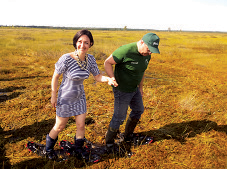First holidaymakers take a trip along 1,500m Ozeravki ecological route — with spyglasses and special swamp footwear (resembling short skis)
 Construction of a new ecological object in the Yelnya Reserve began four months ago — as part of the Ministry for Natural Resources and Environmental Protection and UNDP project. The route along one of Belarus’ oldest reserves was developed to attract tourists who are truly interested in the environmental heritage.
Construction of a new ecological object in the Yelnya Reserve began four months ago — as part of the Ministry for Natural Resources and Environmental Protection and UNDP project. The route along one of Belarus’ oldest reserves was developed to attract tourists who are truly interested in the environmental heritage.Evidently, no better location for the site could have been chosen: Yelnya (in the Vitebsk Region) is the perfect choice. Here, a swamp — recognised as the most ancient European natural object — is found: it is at least 9,000 years old and gives all grounds to believe that the local area appeared owing to a glacier.
The remains of the postglacial tundra have preserved in Yelnya; accordingly, this is a home to rare and endangered flora and fauna species. Only here, willow grouse and black-throated loon live.
Definitely, it’s a great luck for tourists to observe rare birds. However, even if people fail to find them, there is no need to fall into despair: information stands are placed along the ecological route providing all the necessary information. In addition, three observation platforms enable tourists to enjoy the beauty of local primeval nature.
Actually, the Yelnya-Ozeravki ecological route is not a single joint project of the Ministry for Natural Resources and Environmental Protection and the UNDP. As Igor Chulba — who co-ordinates the UNDP programmes in Belarus — explains, three more joint projects shall soon be launched. Wind energy development is among them.
In addition, the UNDP plans to support ‘green’ building in small towns and its specially developed Belarus’ Green Cities programme aims to ensure that ecological matters are taken into account in infrastructure development. Novopolotsk, Polotsk and Novogrudok shall become ‘pioneer’ towns: the UNDP plans to aid the first two in development of the proper infrastructure while focusing on lower energy consumption and ecological lightening of public areas in Novogrudok.
The third project of the Ministry and the UNDP aims at the preservation of Belarusian biodiversity. It would be based on the previously implemented programme which has demonstrated true efficiency. With this in mind, a decision was made to launch a new similar project.











